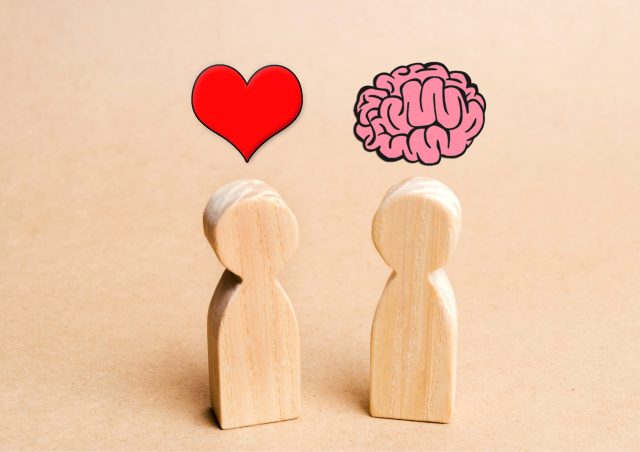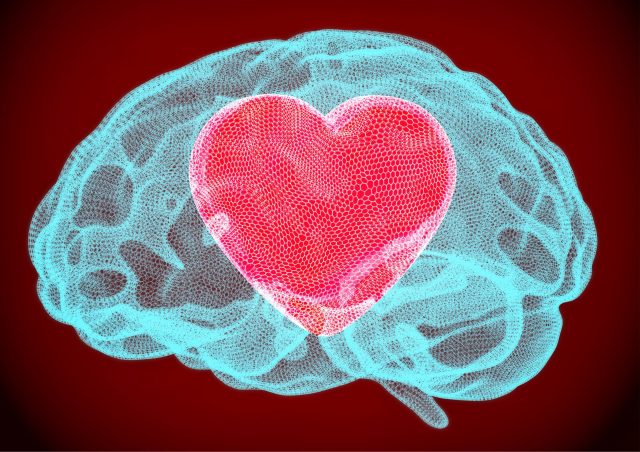The Science of Love: Exploring the Chemistry Behind Romantic Relationships
By Peter Vanderbuild
January 10, 2024 • Fact checked by Dumb Little Man

The Science of Love: Overview
Love is a complicated feeling that has many facets, and for generations, mankind has been fascinated by love. While writers and artists have spent a great deal of time and effort over the years attempting to capture the essence of love, scientists have spent some time and effort delving into the complex systems that drive our romantic interactions.
In this article, we will investigate the fascinating science behind love and get to the bottom of the chemistry that lies at the heart of our most meaningful relationships.
The Neurochemistry of Love

Love, at its foundation, is a complex interaction of multiple neurotransmitters that creates the exciting and fulfilling feelings that we identify with romantic relationships. These experiences are created when two people who care about one another spend time together.
Finding out why we feel the way we do when we are in love can be made easier if we have a better understanding of the neurochemical processes that are involved.
The role of neurotransmitters
Dopamine, oxytocin, and serotonin: Neurotransmitters are chemical messengers in the brain that play a crucial role in transmitting signals between neurons. In the context of love, three neurotransmitters stand out: dopamine, oxytocin, and serotonin.
Dopamine's Connection to Reward and Pleasure
Dopamine is often referred to as the “feel-good” neurotransmitter. It is associated with pleasure, motivation, and reward. When we are in love, the brain releases dopamine, which creates feelings of euphoria, happiness, and excitement. Dopamine reinforces and motivates our desire to seek out our romantic partners, fueling the initial stages of attraction.
Oxytocin's Role in Bonding and Trust
Oxytocin, often called the “cuddle hormone” or “love hormone,” is closely linked to social bonding and trust. It is released during intimate physical contact, such as hugging, kissing, and sexual activity. Oxytocin promotes feelings of attachment and deepens the emotional bond between partners. It is also involved in the formation of long-term relationships and the development of trust and empathy.
Serotonin's Impact on Mood and Attachment
Serotonin is a neurotransmitter associated with mood regulation, emotional stability, and social behavior. In the context of love, serotonin levels influence our mood and attachment patterns.
Low levels of serotonin are often associated with obsessive thinking and heightened emotional intensity, which can contribute to the “butterflies in the stomach” feeling we experience in the early stages of love. Additionally, serotonin is involved in regulating attachment and may play a role in our attraction to specific individuals.
The Role of Hormones

Hormones play a significant role in shaping the dynamics of romantic relationships. They influence our desires, attraction, and even the way we respond to stress. Understanding how hormones function in the context of love can provide insights into the complexities of long-term relationships.
Testosterone and estrogen's influence on desire and attraction
Testosterone, commonly associated with masculinity, and estrogen, typically associated with femininity, both play crucial roles in desire and attraction. Testosterone fuels sexual desire in both men and women, contributing to the initial stages of attraction.
It influences libido, arousal, and the pursuit of sexual gratification. Estrogen, on the other hand, influences a woman's menstrual cycle, and fertility, and can enhance her sense of femininity and attractiveness.
The interplay between testosterone and estrogen influences sexual attraction and desire, contributing to the initial spark in romantic relationships.
The impact of cortisol and stress on relationships
Cortisol is a hormone released in response to stress. In the context of relationships, chronic stress can have a detrimental impact. Elevated cortisol levels can lead to emotional distress, reduced relationship satisfaction, and impaired communication.
Stress can also affect our ability to regulate emotions and respond to conflicts effectively. It is essential for couples to manage stress collectively and individually to maintain a healthy and fulfilling relationship.
How hormonal changes affect the dynamics of long-term love
Hormonal changes can occur over the course of a long-term relationship, influencing the dynamics between partners. For example, the “honeymoon phase” of a relationship, characterized by intense passion and infatuation, is often associated with high levels of dopamine and testosterone.
As a relationship progresses, hormone levels may shift, leading to a decrease in these intense feelings. However, the bond deepens through the release of oxytocin, fostering a sense of trust, attachment, and long-term commitment.
Additionally, hormonal changes during major life events such as pregnancy, childbirth, and menopause can have profound effects on a relationship. For instance, hormonal fluctuations during pregnancy can impact mood and desire, while menopause can lead to changes in estrogen and testosterone levels, affecting sexual desire and intimacy.
Understanding and supporting each other through these hormonal changes is crucial for maintaining a strong and resilient relationship.
RECOMMENDED DATING SITE | REVIEW | VISIT |
|---|---|---|
 | Top dating site with over 16 million active members. Free to Try! |  |
The Power of Physical Attraction

Physical attraction is a fundamental aspect of romantic relationships and plays a crucial role in mate selection. Exploring the science behind physical attraction can help us understand the complex factors that contribute to our preferences and choices in partners.
The science behind physical attraction and mate selection
Physical attraction is influenced by a combination of genetic, cultural, and individual factors. Evolutionary psychology suggests that certain physical traits are considered attractive because they indicate reproductive fitness and genetic health.
Common features of physical attraction include symmetry, facial proportions, body shape, and youthfulness. Additionally, cultural influences shape our perceptions of attractiveness, as beauty standards vary across different societies and time periods.
The role of pheromones in human attraction
Pheromones are chemical substances emitted by the body that can influence behavior and trigger responses in others. While the role of pheromones in human attraction is still under investigation, research suggests that they may play a subtle role in attraction and mate selection.
Pheromones may contribute to signaling fertility, genetic compatibility, and overall physical and sexual attractiveness. However, their influence on human attraction is likely to be more complex and less prominent compared to other animals.
The impact of evolutionary biology on mate preference
Evolutionary biology plays a significant role in shaping our mate preferences. Evolutionary theories propose that our preferences are influenced by our evolutionary past, with the goal of maximizing reproductive success.
For example, men tend to be attracted to physical cues associated with fertility and youth, as these traits suggest the potential for healthy offspring. Women, on the other hand, often value cues of resources, status, and protection in potential partners, as these traits may enhance the survival and well-being of their offspring.
Love and the Brain

The brain is a central player in the experience of love, and understanding its mechanisms can provide valuable insights into the nature of romantic relationships. Brain imaging studies have helped unravel the neural processes involved in love and attachment, revealing the different stages of love and the impact it has on the brain's reward system.
The brain's pleasure center, which is also activated during drug addiction, plays a crucial role in the experience of romantic attraction, as the same regions are involved and hormones released create strong feelings akin to the effects of a brain chemical.
Brain imaging studies on love and attachment
Advances in neuroimaging techniques, such as functional magnetic resonance imaging (fMRI), have allowed researchers to observe the brain activity associated with love and attachment.
These studies have shown that love activates several brain regions, including the prefrontal cortex, the ventral tegmental area (VTA), and the caudate nucleus, which are involved in reward, motivation, and emotional processing.
Additionally, brain imaging studies have explored the differences in brain activation between individuals with secure, anxious, and avoidant attachment styles, shedding light on the neural correlates of different attachment patterns.
The Different Stages of Love: Lust, Attraction, and Attachment
Love can be divided into distinct stages: lust, attraction, and attachment.
Lust
Lust is the initial stage of love and is primarily driven by biological factors and sexual desire. It is characterized by a strong craving for sexual gratification and physical intimacy. The key hormones involved in this stage are testosterone and estrogen, which play a significant role in stimulating sexual desire.
Lust is often accompanied by intense fantasies and a heightened interest in pursuing sexual encounters. While lust forms the foundation of romantic relationships, it alone does not encompass the complete experience of love.
Attraction
The attraction stage is where the feelings of romantic love and infatuation emerge. It is characterized by an intense focus and longing for a specific individual. During this stage, there is increased activity in the brain's reward system, primarily involving the release of dopamine and norepinephrine.
Dopamine creates feelings of pleasure, motivation, and intense exhilaration when in the presence or anticipation of the loved one. Norepinephrine contributes to the sense of excitement and heightened attention.
The attraction stage is often associated with butterflies in the stomach, obsessive thoughts about the person, and a strong desire for reciprocation.
Attachment
The attachment stage is characterized by a deep emotional bond, trust, and long-term commitment. It is the stage where love evolves into a more stable and enduring connection.
The release of oxytocin and vasopressin plays a significant role in this stage. Oxytocin, often referred to as the “cuddle hormone” or “love hormone,” promotes feelings of trust, intimacy, and bonding.
It fosters a sense of emotional closeness and attachment between partners. Vasopressin is involved in pair bonding and promoting monogamous behavior. In the attachment stage, couples feel a sense of security, contentment, and a desire for long-term companionship.
The effects of love on the brain's reward system
Love activates the brain's reward system, which is responsible for feelings of pleasure and motivation. When we are in love, the brain releases dopamine, a neurotransmitter associated with reward and pleasure.
This dopamine surge creates intense feelings of happiness, euphoria, and motivation, reinforcing the desire to be with and pursue a romantic partner. This reward-based system explains the exhilaration and the “high” often experienced during the early stages of romantic love.
Love and Attachment Styles

Attachment theory suggests that our early attachment experiences with caregivers shape our internal working models of relationships, which in turn influence our adult relationships. Understanding attachment styles can provide valuable insights into communication patterns, emotional intimacy, and the dynamics of romantic relationships.
The influence of early attachment experiences on adult relationships
Our early attachment experiences, particularly with our primary caregivers, form the basis for our beliefs about ourselves and others in relationships. Secure attachment experiences, characterized by consistent and responsive caregiving, tend to foster a sense of security, trust, and healthy emotional regulation.
In contrast, insecure attachment experiences, such as inconsistent or neglectful caregiving, can lead to the development of anxious or avoidant attachment styles in adulthood. These attachment styles influence how individuals perceive and engage in romantic relationships.
Secure, anxious, and avoidant attachment styles
A secure attachment style is characterized by a positive view of oneself and others. Individuals with a secure attachment style feel comfortable with both intimacy and independence, have healthy communication patterns, and experience trust and satisfaction in their relationships.
An anxious attachment style is characterized by a fear of abandonment and a preoccupation with the availability and responsiveness of the partner. Individuals with an anxious attachment style often seek excessive reassurance, worry about rejection, and may display clingy or possessive behaviors.
Avoidant attachment style is characterized by a fear of intimacy and a desire for independence. Individuals with an avoidant attachment style tend to value self-reliance, struggle with emotional vulnerability, and may engage in behaviors that create distance or push their partners away.
How do attachment styles shape communication and intimacy?
Attachment styles significantly influence communication patterns and intimacy in romantic relationships. Secure individuals tend to have open and effective communication, as well as a healthy balance of independence and closeness.
They are comfortable expressing needs and emotions while being responsive to their partner's needs.
Anxious individuals often seek constant reassurance and may engage in frequent communication to alleviate their fears of abandonment. They may exhibit a tendency to amplify small conflicts and display heightened emotional reactivity.
Love's Impact on Health and Well-being

Love and long-term relationships have been shown to have positive effects on both physical and mental health. The presence of love and a supportive partnership can serve as a buffer against stress, promote overall well-being, and contribute to a healthier life.
The positive health effects of love and long-term relationships
Being in a loving and committed relationship has been associated with numerous health benefits. Research suggests that individuals in stable relationships tend to have lower rates of cardiovascular disease, reduced risk of chronic illnesses, and longer lifespans compared to those who are single or in less fulfilling relationships.
Love and companionship can contribute to a healthier lifestyle, as partners often support each other in adopting healthier habits, such as exercise, proper nutrition, and stress management.
Love as a buffer against stress and illness
Love and emotional support from a partner can serve as a protective factor against stress and its negative effects on health. When individuals feel loved and supported, they experience lower levels of stress hormones, such as cortisol.
Love provides a sense of security, comfort, and emotional stability, which helps individuals cope with life's challenges more effectively.
Additionally, loving relationships can provide a safe space for open communication, problem-solving, and sharing burdens, reducing the impact of stress on overall well-being.
The role of social support in relationship satisfaction
Love and long-term relationships offer an important source of social support, which plays a crucial role in relationship satisfaction and well-being.
Social support from a partner, including emotional support, understanding, and companionship, has been linked to higher levels of relationship satisfaction and overall happiness.
Sharing life experiences, having someone to confide in, and feeling understood and valued contribute to a sense of belonging and fulfillment in a relationship. Social support from a partner also helps individuals navigate difficult times, providing comfort and reassurance.
RECOMMENDED DATING SITE | REVIEW | VISIT |
|---|---|---|
 | Top dating site with over 16 million active members. Free to Try! |  |
Conclusion
Love is a captivating blend of biology, chemistry, and psychology. Understanding the science behind love can provide us with valuable insights into the mechanisms that govern our romantic relationships.
By exploring the neurochemistry, hormones, attraction, attachment, and the impact of love on our well-being, we can enhance our understanding of what it means to love and be loved.
Remember, while science can shed light on the chemistry of love, it is the unique experiences and connections we share with our partners that truly make love a profound and beautiful human experience.
FAQs
Can love change over time?
Yes, love can change over time. Love is a complex and dynamic emotion that evolves as relationships progress. The intense feelings experienced during the early stages of a relationship, often referred to as “passionate love,” may naturally transition into a deeper and more stable form of love known as “companionate love.”
This shift can involve a stronger emphasis on emotional intimacy, trust, and long-term commitment. External factors, personal growth, and relationship dynamics can all influence the evolution of love over time.
Can love exist without physical attraction?
Love can exist without physical attraction, although physical attraction often plays a role in the initial stages of romantic relationships. While physical attraction can spark interest and draw individuals together, it is not the sole determinant of love.
Emotional connection, shared values, compatibility, and mutual respect are equally important factors that contribute to the development of love.
In some cases, emotional intimacy and deep connections can be the foundation of love, even in the absence of intense physical attraction.
Can a person have different attachment styles in different relationships?
Yes, it is possible for a person to have different attachment styles in different relationships. Attachment styles are influenced by early experiences and relationships, but they are not fixed or immutable traits.
Individuals may develop different attachment patterns based on the specific dynamics and experiences within each relationship.
Peter Vanderbuild
Trevor Fields is a tech-savvy content strategist and freelance reviewer with a passion for everything digital—from smart gadgets to productivity hacks. He has a background in UX design and digital marketing, which makes him especially tuned in to what users really care about. Trevor writes in a conversational, friendly style that makes even the most complicated tech feel manageable. He believes technology should enhance our lives, not complicate them, and he’s always on the hunt for tools that simplify work and amplify creativity. Trevor contributes to various online tech platforms and co-hosts a casual podcast for solopreneurs navigating digital life. Off-duty, you’ll find him cycling, tinkering with app builds, or traveling with a minimalist backpack. His favorite writing challenge? Making complicated stuff stupid simple.




